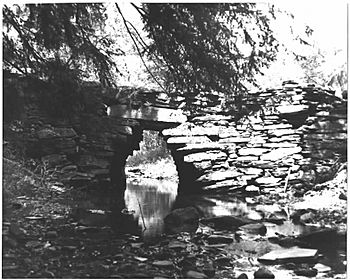Bell Creek (Tunkhannock Creek tributary) facts for kids
Quick facts for kids Bell Creek |
|
|---|---|

Bell Creek at the bridge in Gibson Borough
|
|
| Physical characteristics | |
| Main source | small unnamed pond to the west of Kennedy Hill in Gibson Township, Susquehanna County, Pennsylvania 1,493 feet (455 m) |
| River mouth | Tunkhannock Creek in Gibson Township, Susquehanna County, Pennsylvania near South Gibson 945 feet (288 m) 41°43′59″N 75°38′01″W / 41.73307°N 75.63363°W |
| Length | 5.2 miles (8.4 km) |
| Basin features | |
| Progression | Tunkhannock Creek → Susquehanna River → Chesapeake Bay |
| Tributaries |
|
Bell Creek is a small river, also called a tributary, that flows into Tunkhannock Creek. It's located in Susquehanna County, Pennsylvania, in the United States. The creek is about 5.2 miles (8.4 km) long. It runs through Gibson Township.
The area of land that drains into the creek, called its watershed, is about 5.64 square miles (14.6 km2). The ground around the creek has different types of soil and rock. These include Wisconsinan Till (a type of glacial soil), alluvium (river deposits), and bedrock. You can also find wetlands and lakes near the creek.
Bell Creek flows through Potter Lake. A special bridge that is part of the National Register of Historic Places crosses Bell Creek. The creek's watershed is a great place for fish. It is known as a Coldwater Fishery and a Migratory Fishery.
Contents
Where Bell Creek Flows
Bell Creek starts in a very small pond. This pond is west of Kennedy Hill. The creek then flows south. It passes through another pond before reaching Potter Lake.
In Potter Lake, two small streams join Bell Creek from the left side. After the lake, the creek flows south-southwest. It enters a wetland and another lake. Here, a stream from the right side joins it.
The creek then flows south for a while. It turns south-southwest again. After about a mile, another stream from the right joins it. The creek then turns south-southeast for a short distance.
It turns south-southwest again for a few miles. Another stream from the right joins it here. Finally, Bell Creek crosses Pennsylvania Route 92. It then meets Tunkhannock Creek.
Bell Creek is about 5.2 miles (8.4 km) long. It joins Tunkhannock Creek about 29.32 miles (47.19 km) upstream from where Tunkhannock Creek ends.
Land and Rocks Around the Creek
The land near where Bell Creek joins Tunkhannock Creek is about 945 feet (288 m) above sea level. Where Bell Creek begins, the land is higher. It is about 1,493 feet (455 m) above sea level.
Near the mouth of Bell Creek, the ground is made of alluvial fan deposits. Further upstream, you'll find alluvium and bedrock. This bedrock is made of sandstone and shale. The valley around the lower part of the creek has mostly bedrock. It also has a type of soil called Wisconsinan Till.
Higher up the creek, the ground is mostly Wisconsinan Till. There are also some areas of alluvium. You can also see patches of wetlands and lakes. The valley of Bell Creek in its upper parts is special. It has a "beaded valley" shape. This means it was not changed much by glaciers carving it out. But it was greatly affected by glaciers leaving behind large amounts of glacial till. This till partly or fully blocks some valleys.
Creek's Surroundings and Wildlife
The watershed of Bell Creek covers an area of 5.64 square miles (14.6 km2). The mouth of the creek is in the Lenoxville map area. The source is in the Thompson map area. The creek also flows through the Harford map area. The mouth of the creek is less than 1 mile (1.6 km) from South Gibson.
Potter Lake is located on Bell Creek. It is a large, open-water area. It used to be more like a bog. But dams built by beavers and people have raised the water levels. This has covered much of the bog plants. Potter Lake is listed in the Susquehanna County Natural Areas Inventory.
A company called Williams Field Services Company, LLC. once got permission. They built a 16-inch (41 cm) natural gas pipeline. They also built timber bridges over Bell Creek and its smaller streams.
History of Bell Creek
Bell Creek was officially added to the Geographic Names Information System on August 2, 1979. Its special ID number is 1169146.
The creek is named after Captain Bell. He was one of the first people to settle in this area.
A bridge carrying Pennsylvania Route 92 crosses Bell Creek. It is a steel bridge built in Gibson Township in 1951. This bridge is 39.0 feet (11.9 m) long. Another special bridge crosses Bell Creek in South Gibson. It is a stone arch bridge. It carries State Route 2067. This bridge was added to the National Register of Historic Places on June 22, 1988.
Animals and Plants
The watershed of Bell Creek is very important for fish. It is called a Coldwater Fishery. This means the water is cold enough for certain fish. It is also a Migratory Fishery. This means fish travel through it to lay their eggs.
Wild trout naturally live and reproduce in Bell Creek. You can find them from the upper parts of the creek all the way to its mouth.

